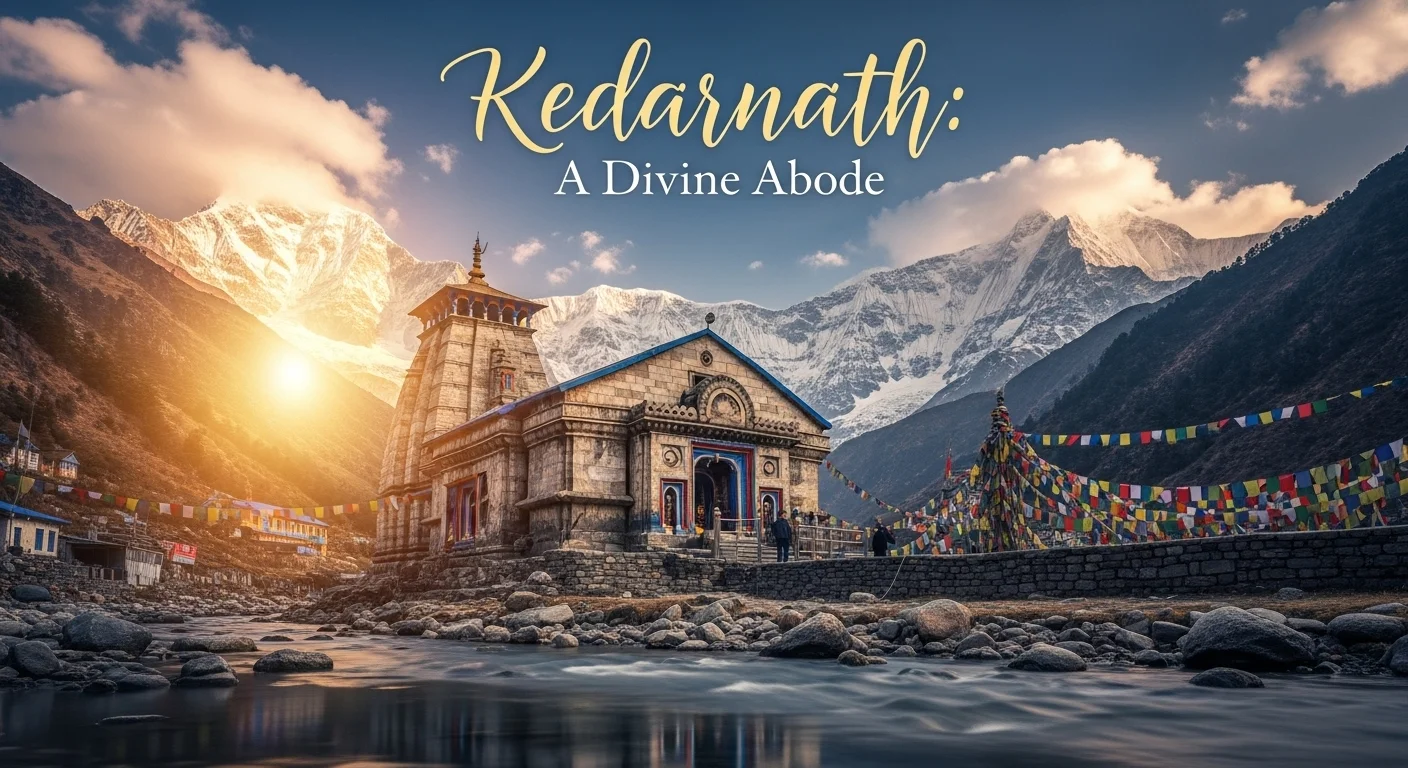Introduction: The Sacred Farewell of Kedarnath
Every year, the closing of the Kedarnath Temple gates is not just a logistical event it’s a deeply emotional, ritualistic, and spiritual ceremony. For devotees who have made the arduous journey to the “Kedar Kona,” the closing marks a symbolic end to the pilgrimage season and a transition into the silent, snowy months ahead.
If you plan to visit in late 2025, understanding this event when it happens, how it unfolds, and how you can experience it is essential. In this blog, I dive into everything: from the official dates and rituals, to travel logistics, firsthand narratives, pitfalls, alternate pilgrimage options, and tips for capturing the moment.
When Does the Kedarnath Gate Close for 2025?
Official Dates & Tentative Schedules
- The opening of the Kedarnath Temple for 2025 was 2 May 2025 at 7:00 AM, announced on Maha Shivaratri.
- The closing (or “kapat bandh”) is traditionally scheduled around Bhai Dooj, which falls two days after Diwali.
- Many sources list the closing date as 3 November 2025 at 8:30 AM (tentative)
- Others, especially pilgrimage-tour sites, still show 23 October 2025 (tentative) as the date, aligning with Bhai Dooj of that year.
- Some sources mention that the final date is declared on Vijayadashami (Dussehra) as per Hindu Panchang, and that the temple is then closed after the morning Pooja Archana on Bhai Dooj.
Conclusion on date: As of now, the most supported date seems to be 3 November 2025, at 8:30 AM, but you should verify closer to the festival season via BKTC (Badrinath-Kedarnath Temple Committee) announcements or local authorities.
Why This Timing?
- The timing is linked to Hindu festival cycles: Diwali, Vijayadashami, and Bhai Dooj influence the selection.
- Weather factors play a role — by November, heavy snowfall and extreme cold make the region inaccessible.
- It’s a long-standing tradition that the idol is carried to Ukhimath for winter worship so the closing date ensures that movement is completed before snow blocks the routes.
What Happens During the Closing Ceremony (Kapat Bandh Rituals)
This is not a sudden “lock the doors” event it’s an elaborate, sacred procession, filled with chants, devotion, and emotion.
Preliminary Rituals & Preparations
- In the early morning (often before dawn), the Samadhi Puja is performed for the self-manifested Shiva Linga in the sanctum.
- Priests, Vedpathis, and the head Rawal make final offerings and conduct Vedic mantras.
- The temple interiors are decorated with flowers, garlands, lamps, and the priests dress in their ceremonial vestments.
The Utsav Doli / Palanquin Journey
- The Panchmukhi Utsav Doli (a decorated palanquin carrying the deity’s representation) is brought out from the temple. At this moment, the doors (kapats) are ceremoniously shut.
- Devotees chant “Om Namah Shivay”, “Jai Baba Kedar”, and other hymns.
- In many years, the Indian Army band plays devotional tunes to enhance the spiritual ambience.
- Once the palanquin emerges, devotees often follow behind on foot, singing hymns, until the procession moves toward Rampur, Guptkashi, and ultimately to Ukhimath.
- The Doli often stays overnight at intermediate stops e.g. Rampur, Guptkashi before reaching Ukhimath for winter residence.
Emotional Highlights & Symbolism
- Witnessing the doors being shut is deeply symbolic it represents the divine departure of Lord Kedarnath from his Himalayan abode.
- Many devotees use this moment for silent prayer, tears, or meditation the mountains echo with sacred chants.
- There may be mass bhandaras (prasadam distribution) for pilgrims at various points along the Doli’s path.
Travel Narrative: A Hypothetical Journey to Witness Kapat
To make this more vivid, let me sketch a hypothetical travel narrative for someone aiming to catch the closing ceremony.
Day –3: Arrival & Acclimatization
- Reach Rishikesh / Haridwar, then head toward Gaurikund (via Dehradun/Rudraprayag) rest, prepare, and acclimatize.
- Stock up on warm clothing, medicines, extra food, and backup gear.
Day –2: Trek to Kedarnath
- Start early from Gaurikund, covering ~16 km trek through forest, boulders, and steep paths.
- Arrive at Kedarnath village by evening, settle in, rest, and mentally prepare for the next day’s ceremony.
Day –1: Spiritual Offerings & Vigil
- Attend the final morning prayers, Aarti and Archana, perhaps do Havan if possible.
- In the evening, many devotees stay awake near the temple area, chanting, singing bhajans, or meditating under the Himalayan sky.
Day of Closure (Day 0)
- Very early (pre-dawn), rise and get to the temple courtyard.
- Watch the rituals: Samadhi Puja, closing of kapats, exit of Doli.
- Join the processional walk for as long as feasible, capturing the spiritual energy in every step.
- Return via the same or alternate route depending on logistics.
Post-Closure
- If staying nearby (e.g. at Guptkashi or Ukhimath), attend the reinstallation ceremony when the Doli reaches the winter abode.
- Photo journaling, writing, and reflecting on the emotional journey.
Practical Tips for Travelers Planning to Catch the Closing
|
Tip |
Details / Why It Matters |
|
Arrive early |
Airports, roads, lodging fill up during closing season |
|
Check official announcements |
The closure date may shift slightly — monitor BKTC / Uttarakhand Govt |
|
Stay flexible |
Weather, landslides, or route closures can force changes |
|
Carry layers & gear |
Windproof jackets, thermal wear, gaiters, gloves, headlamps |
|
Keep permits ready |
Yatra registration, health certificates, identity proof |
|
Book stay in advance |
Kedarnath village, Guptkashi, or accessible points can run out |
|
Helicopter option (if available) |
If road/trek routes become difficult, check for backup air options |
|
Emergency contacts & medical kit |
Altitude sickness, slips, cold injuries have first aid & local helplines |
|
Capture with respect |
Use cameras discreetly during rituals; follow temple rules |
|
Plan for return |
Exit routes may be crowded leave buffer time |
After the Closure: What Happens in Winter
Winter Worship in Ukhimath
- After closing, the idol of Lord Kedarnath is installed in Omkareshwar Temple, Ukhimath, and worship continues there through the winter.
- Devotees who could not reach Kedarnath often visit Ukhimath to receive blessings in the off-season.
Region Becomes Inaccessible
- Heavy snow and avalanches make the Kedarnath region inaccessible till April / May.
- All trekking, road, and helicopter services cease during this period.
- Locals and priests shift base; the temple remains sealed.
Preparations for Reopening
- Months before reopening, path clearances, snow removal, structural checks, and ritual planning begin.
- The opening date is again announced on Maha Shivaratri, with the same elaborate ceremonies in reverse.
Risks & Challenges During Closing Season
- Weather volatility: sudden snow, storms, or temperature drops
- Route hazards: landslides, slippery trails, rockfall
- Crowd congestion: as many pilgrims target the closing window
- Altitude and fatigue: unique strain at high elevation
- Limited medical support: facilities become minimal or stretched
- Communication blackouts: mobile/internet networks may be patchy
Always travel with insurance, backup plans, and local support.
Why Witness the Closing? Spiritual & Emotional Value
- It’s a once-a-year divine spectacle: the closing of gates is as significant as the opening.
- The emotional weight of realizing that “this is the last darshan for months” can move devotees to tears.
- Being part of the devotional procession, joining in chants and footsteps, deepens your connection with the shrine.
- For photographers and storytellers, the interplay of Himalayan light, chants, cold air, and solemn ritual offers rich imagery.
- It underscores the cyclical nature of pilgrimage: arrival, worship, departure, and wait until the return.
Sample Itinerary Focused Around Closing (7 Days Approx.)
|
Day |
Location |
Activity |
|
1 |
Haridwar / Rishikesh |
Travel in, rest, acclimatize |
|
2 |
Move toward Gaurikund |
Via Rudraprayag / Guptkashi |
|
3 |
Trek to Kedarnath |
Settle at guesthouse / temple area |
|
4 |
Rest / final offerings |
Light trekking, last rituals |
|
5 |
Closing Day |
Early morning rituals, watch Doli depart, start descent |
|
6 |
Stay en route |
At Guptkashi or intermediate point, attend local Doli reception |
|
7 |
Return / exit toward base |
Reflect and depart |
You may adjust the schedule by adding extra days for buffer or acclimatization.
Must Read: 10 Forgotten Indian Temples: Ancient Secrets Hidden in Forests & Caves (2025)
Final Thoughts
Visiting Kedarnath before the temple gates close is not just a spiritual act — it’s a journey through faith, endurance, and Himalayan beauty. Witnessing the closing ceremony is a once-in-a-lifetime experience for devotees, offering divine peace and a sense of completion.
So, if you’re planning to visit in October or early November 2025, start preparing now. The mountains await, and the divine aura of Kedarnath promises blessings beyond measure.
Must Read: 10 Unreal & Most Beautiful Places in India: Must-Visit Hidden Gems
FAQs (Frequently Asked Questions)
Q1. Can I still go to Kedarnath after the gates close?
Ans: No, the temple becomes inaccessible. But worship continues at Ukhimath’s Omkareshwar Temple.
Q2. Can I witness the closing if I’m midway on the trail?
Ans: It’s risky — you might miss key rituals or get stranded by weather. Best to plan to be inside Kedarnath village the night before.
Q3. Will there be transportation back on the same day?
Ans: Depending on route and conditions, descent may begin later. But crowded paths and limited services might slow you down — plan buffer time.
Q4. Is the 2025 closing date fixed?
Ans: Not completely. While the date is tied to Bhai Dooj, it can be confirmed only after Dussehra (Vijayadashami) per temple committee.
Q5. Should I hire a guide or porter?
Ans: Highly recommended, especially for carrying gear, navigating the processions, or dealing with last-minute changes.
Thank you for trusting Outdoorkeeda as your guide for your travel needs.







